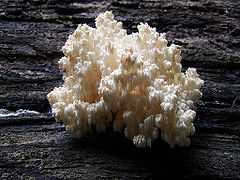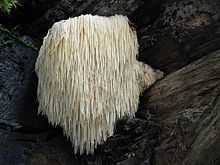Hericium
| Hericium | |
|---|---|
 | |
| Hericium coralloides | |
| Scientific classification | |
| Kingdom: | Fungi |
| Division: | Basidiomycota |
| Class: | Agaricomycetes |
| Order: | Russulales |
| Family: | Hericiaceae |
| Genus: | Hericium Pers. (1794) |
| Type species | |
| Hydnum coralloides Scop. (1772) | |
| Species | |
|
See text. | |
Hericium is a genus of edible mushrooms in the Hericiaceae family. Species in this genus are white and fleshy and grow on dead or dying wood; fruiting bodies resemble a mass of fragile icicle-like spines that are suspended from either a branched supporting framework or from a tough, unbranched cushion of tissue. This distinctive structure has earned Hericium species a variety of common names—monkey's head, lion's mane, and bear's head are examples. Taxonomically, this genus was previously placed within the order Aphyllophorales, but recent molecular studies now place it in the Russulales.
Hericium means hedgehog in Latin.[1]
History
The genus Hericium was originally described by Christian Hendrik Persoon in 1794. It was mentioned by Elias Magnus Fries in the Systema Mycologicum (1822); Fries considered it to be synonymous with the tribe Merisma of the genus Hydnum. In 1825 he recognized Hericium as a distinct genus, although not in the same sense as the genus would be known later.[2]
Phylogenetics
In 2004, the phylogenetic relationships of Hericium species were analysed by comparing the rDNA internal transcribed spacer sequences of H. abietis, H. alpestre, H. americanum, H. coralloides, H. erinaceum, H. erinaceus and H. laciniatum. This analysis separated H. erinaceum from the six other Hericium species, and showed that H. erinaceus, H. abietis, H. americanum, and H. coralloides are closely related each to other but genetically diverged from H. alpestre and H. laciniatum.[3] Molecular genetic markers have been developed that allow for quick and sensitive identification of Hericium species using the polymerase chain reaction.[4]
The Hericiaceae family, to which Hericium belongs, belongs to the russuloid clade of basidiomycetes, making it phylogenetically related to the Auriscalpiaceae, the Bondarzewiaceae, and the Echinodontiaceae.[5][6]
Description
The fruit bodies typically have short stalks and are attached laterally to the host tree. Mature specimens are easily identified by drooping spines which hang down; the spines may be arranged in clusters or more usually, in rows. Positive identification of immature specimens can be more difficult as they often begin as a single clump, developing their branches as they age. They have no caps and contain spiny amyloid spores and numerous gloeopleurous hyphae filled with oil droplets.[7][8] The spores are spherical to ellipsoid, smooth or covered with very fine warts.[9]
Distribution and habitat
Hericium species are found in many countries around the world and may grow high up on dead tree trunks.[10]
Uses
All four species found in North America are edible and are among the safest and most unmistakable mushrooms. Hericium are also widely consumed in China. This genus is easily cultivated.[10]
In China and Japan, species of Hericium are highly valued for their medicinal properties;[11] in particular, H. erinaceus is used in traditional Chinese medicine.[12] In recent decades there has been considerable research interest in the bioactive properties of this species, and several compounds isolated from H. erinaceus have biological activities, including cytotoxic effects on cancer cells, stimulatory effects on nerve growth factor synthesis,[13] antimicrobial and nematicidal activity, and antitumor activity.[14][15]
Hericium species can be purchased in dried form for use in cooking and as medicine.
Species
- Hericium abietis
- Hericium alpestre
- A European species, confirmed—using sexual incompatibility studies—to be a distinct species from H. coralloides in 1983. Found in montane areas, typically on newly fallen trunks and stumps of Fir (Abies species). Spores are 5–6.5 by 4.5–5.5 µm.[16]
- Hericium americanum ("Bear's-head tooth")
- Hericium bharengense[17]
- Hericium botryoides
- Hericium caput-medusae
- Hericium cirrhatum ("Spine-face")
- Hericium clathroides
- Hericium coralloides ("Comb tooth"; "coral spine fungus")
- Widely distributed in Europe, and found on Beech (Fagus sylvatica) and Fir. Spores have dimensions of 3.5–5 by 3–4 µm.[16]
- Hericium echinus
- Hericium erinaceus ("Bearded tooth", "Tree hedgehog, "Monkeyhead")
- Found on living oak and beech trees.[16]
- Hericium grande
- Hericium hystrix
- Hericium unguiculatum
- Hericium yumthangense[19]
Further reading
- Ginns, J. (1985). Hericium in North America: cultural characteristics and mating behavior. Canadian Journal of Botany 63: 1551-1563.
- Harrison, K. A. (1973). The genus Hericium in North America. Michigan Botanist 12: 177–194.
References
- ↑ Spore Print, Quarterly Newsletter of the Edmonton Mycological Society
- ↑ Miller LW. (1933). "The genera of Hydnaceae". Mycologia 25 (4): 286–302. doi:10.2307/3754097. JSTOR 3754097.
- ↑ Park HK, Ko HG, Kim SH, Park WM. (2004). "Molecular identification of Asian isolates of medicinal mushroom Hericium erinaceum by phylogenetic analysis of nuclear ITS rDNA". Journal of Microbial Biotechnology 14: 816–21.
- ↑ Lu L, Li J, Cang Y (2002). "PCR-based sensitive detection of medicinal fungi Hericium species from ribosomal internal transcribed spacer (ITS) sequences". Biological & Pharmaceutical Bulletin 25 (8): 975–80. doi:10.1248/bpb.25.975. PMID 12186429.
- ↑ Larsson E, Larsson K-H. (2003). "Phylogenetic relationships of russuloid basidiomycetes with emphasis on aphyllophoralean taxa". Mycologia 95 (6): 1035–65. doi:10.2307/3761912. PMID 21149013.
- ↑ Miller SL, Larsson E, Larsson K-E, Verbeken A, Nuytinck J. (2006). "Perspectives in the new Russulales". Mycologia 98 (6): 960–70. doi:10.3852/mycologia.98.6.960. PMID 17486972.
- ↑ Volk T. "Hericium americanum, the pom pon mushroom, a.k.a. Lion's mane, the bear's head tooth fungus, monkey head, or for this month, the icicle mushroom". Fungus of the Month for January 2003. Retrieved 2009-06-27.
- ↑ Kuo M. "The Genus Hericium (MushroomExpert.Com)". Retrieved 2009-06-27.
- ↑ Ellis JB, Ellis MB. (1990). Fungi without Gills (Hymenomycetes and Gasteromycetes): an Identification Handbook. London, UK: Chapman and Hall. pp. 102–3. ISBN 0-412-36970-2.
- ↑ 10.0 10.1 "Best Edible Wild Mushrooms - AmericanMushrooms.com". Retrieved 2009-06-27.
- ↑ Cannon PF, Kirk PM. (2007). Fungal Families of the World. Wallingford, UK: CABI. p. 158. ISBN 0-85199-827-5.
- ↑ Halpern GM. (2007). Healing Mushrooms. Garden City Park, NY: Square One Publishers. pp. 107–. ISBN 0-7570-0196-3. Google Books
- ↑ Mori K, Obara Y, Hirota M, Azumi Y, Kinugasa S, Inatomi S, Nakahata N. (2008). "Nerve growth factor-inducing activity of Hericium erinaceus in 1321N1 human astrocytoma cells". Biological & Pharmaceutical Bulletin 31 (9): 1727–32. doi:10.1248/bpb.31.1727. PMID 18758067. Retrieved 2009-06-28.
- ↑ Mizuno T, Wasa T, Ito H, Suzuki C, Ukai N. (1992). "Antitumor-active polysaccharides isolated from the fruiting body of Hericium erinaceum, an edible and medicinal mushroom called yamabushitake or houtou". Bioscience, Biotechnology, and Biochemistry 56 (2): 347–48. doi:10.1271/bbb.56.347. PMID 1368310.
- ↑ Mizuno Y., Takashi (1995). "Hericium erinaceum: bioactive substances and medicinal utilization". Food Reviews International 11: 173–78. doi:10.1080/87559129509541027.
- ↑ 16.0 16.1 16.2 Hallenberg N. (1983). "Hericium coralloides and H. alpestre (Basidiomycetes) in Europe". Mycotaxon 18 (1): 181–89.
- ↑ Das K, Stalpers J, Eberhardt U. (2011). "A new species of Hericium from Sikkim Himalaya (India)". Cryptogamie Mycologie 32 (3): 285–93. doi:10.7872/crym.v32.iss3.2011.285.
- ↑ Pegler DN., D.N. (2003). "Useful fungi of the world: the monkey head fungus". Mycologist 17 (3): 120–21. doi:10.1017/S0269915X03003069.
- ↑ Das K, Stalpers JA, Stielow JB. (2014). "Two new species of hydnoid-fungi from India". IMA Fungus 4 (2): 359–69. doi:10.5598/imafungus.2013.04.02.15.

